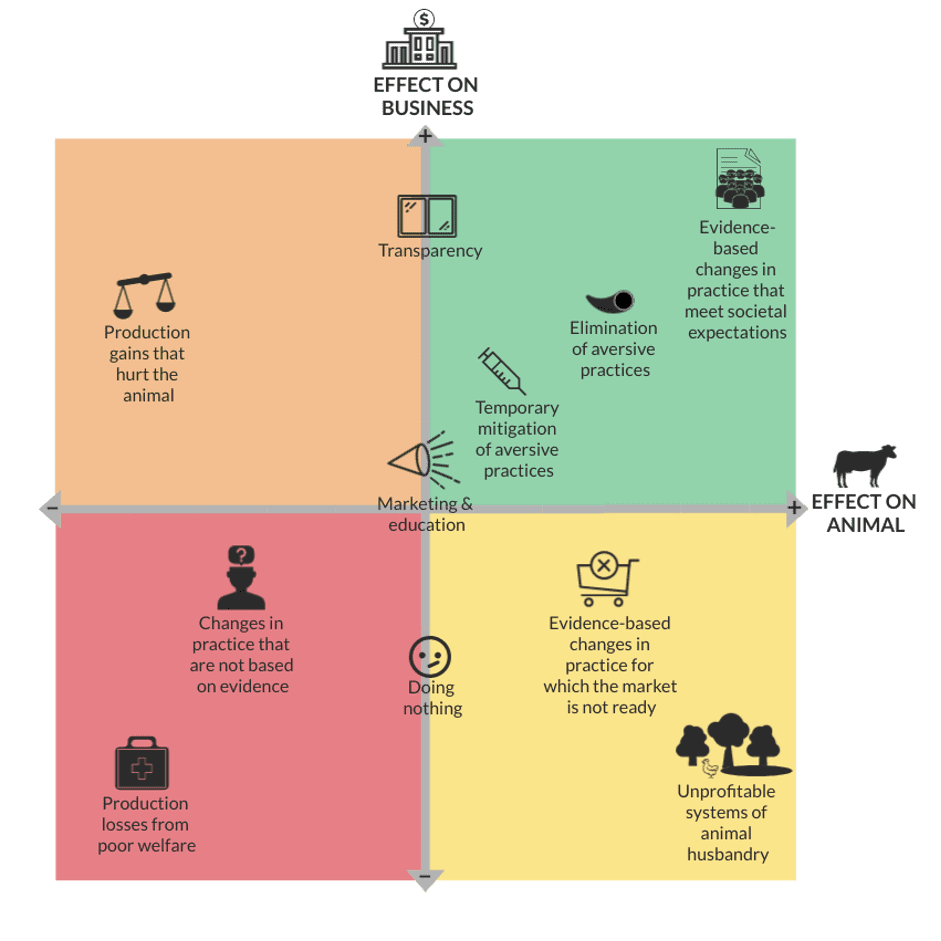SCIENTISTS from the University of Queensland have developed a decision support tool to help people with farm animals under their care to make evidence-based decisions about changes in practice to improve animal welfare.
Many livestock companies are aware that Australians have growing concerns over the welfare of animals.
But it costs money to improve the welfare of farm animals – often a substantial investment by the business.

Continuum of animal welfare. The cost to ensure that the welfare of animals is not negative may be considered an essential cost. The economic advantage from investment to move the level of animal welfare to more positive states on the continuum is challenging to evaluate, although market protection afforded by gaining and maintaining consumer and community support may well justify the costs to ensure positive states of animal welfare.
There are many financial, practical, and ethical factors for businesses to consider when improving animal welfare, and the optimal course of action is not always obvious.
An article published last week in the Agriculture journal seeks to address this dilemma facing businesses and farmers. The article, titled “Costs and Benefits of Improving Farm Animal Welfare,” written by animal welfare scientists in a collaboration between the Animal Welfare Science Centre and The Animal Welfare Collaborative at The University of Queensland.
The article carefully weighs the costs and benefits of improving and not improving farm animal welfare, with a particular focus on the Australian livestock sector.
It also provides an easy-to-use decision tool to support people with farm animals under their care to make evidence-based decisions about changes in practice to improve animal welfare.

Decision tool for businesses considering changes in practice to improve farm animal welfare. The horizontal axis depicts the effect of the change in practice on the welfare of the animal, with more positive effects towards the right. The vertical axis depicts the effect of the change in practice on the profitability of the business, with more positive effects towards the top. Source: Fernandes, J.N.; Hemsworth, P.H.; Coleman, G.J.; Tilbrook, A.J. Costs and Benefits of Improving Farm Animal Welfare. Agriculture 2021, 11, 104. https://doi.org/10.3390/agriculture11020104
Many of the costs are obvious.
For example, training of stock people, reconfiguration of pens, and administration of pain relief can improve farm animal welfare, but all of these come with costs.
On the other hand, the costs of not improving animal welfare may be less obvious but are just as significant.
For instance, businesses may run the risk of losing a portion of their customers to higher welfare products, they may be shut out of certain international markets almost overnight, they may be forced to implement costly changes with the introduction of new legislation, or they may gradually lose their social licence to farm by not ensuring good animal welfare.
The benefits of improving farm animal welfare are also difficult to evaluate from a purely economic perspective.
Most farmers acknowledge that animals with poor welfare are unlikely to produce at optimal levels, but there may be other benefits of improving farm animal welfare that extend beyond production gains. These include benefits to the animal, positive effects on the workforce, competitive advantage for businesses, mitigation of risk, and positive social consequences.
The full article weighs these considerations and integrates them into a decision tool that can assist people with farm animals under their care, and the authors highlight the need for further empirical evidence to improve decision-making in animal welfare.
Source: University of Queensland

I live in Victoria have often driven through farm area and lack of trees and water on a lot of farms all huddled under one tree no shelter so it worries me poor things regards Karren Chuter
Good stockman are good stockman, they take care of their land and livestock because that is their living and their life.
This paper was written by acidemics justifying their existence to people who rule by emotion and opinion.
Is using genetics that are not matched to your environment a breech of animal welfare?
Probably should be.
Having sound animal welfare principles to operate your livestock business shouldn’t be an issue where farmers need to think twice.
It is by no means a difficult issue to deal with and is quite simple if one considers themselves to be a professional livestock farmer. Shade, shelter, clean water and good quality feed are the key ingredients. This should lead the way on how we handle our animals and how we treat them whether they are in the paddock or the yards. Breeding animals with sound temperament is an esential element as is ease of handling with good facilities and sound operator education.
It isn’t rocket science and it is something professional livestock farmers are already applying to their businesses and profiting from.